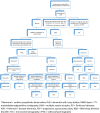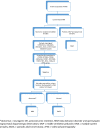A Review on the Clinical Diagnosis of Multiple System Atrophy
- PMID: 35986227
- PMCID: PMC10485100
- DOI: 10.1007/s12311-022-01453-w
A Review on the Clinical Diagnosis of Multiple System Atrophy
Abstract
Multiple system atrophy (MSA) is a rare, adult-onset, progressive neurodegenerative disorder with major diagnostic challenges. Aiming for a better diagnostic accuracy particularly at early disease stages, novel Movement Disorder Society criteria for the diagnosis of MSA (MDS MSA criteria) have been recently developed. They introduce a neuropathologically established MSA category and three levels of clinical diagnostic certainty including clinically established MSA, clinically probable MSA, and the research category of possible prodromal MSA. The diagnosis of clinically established and clinically probable MSA is based on the presence of cardiovascular or urological autonomic failure, parkinsonism (poorly L-Dopa-responsive for the diagnosis of clinically established MSA), and cerebellar syndrome. These core clinical features need to be associated with supportive motor and non-motor features (MSA red flags) and absence of any exclusion criteria. Characteristic brain MRI markers are required for a diagnosis of clinically established MSA. A research category of possible prodromal MSA is devised to capture patients manifesting with autonomic failure or REM sleep behavior disorder and only mild motor signs at the earliest disease stage. There is a number of promising laboratory markers for MSA that may help increase the overall clinical diagnostic accuracy. In this review, we will discuss the core and supportive clinical features for a diagnosis of MSA in light of the new MDS MSA criteria, which laboratory tools may assist in the clinical diagnosis and which major differential diagnostic challenges should be borne in mind.
Keywords: Cerebellar ataxia; Multiple system atrophy; Neurogenic orthostatic hypotension; Parkinsonism; Urogenital failure.
© 2022. The Author(s).
Conflict of interest statement
Full financial disclosures for the past 12 months:
Iva Stankovic: Dr. Stankovic has nothing to disclose.
Alessandra Fanciulli: Dr. Fanciulli reports royalties from Springer Nature Publishing Group, speaker fees and honoraria from International Parkinson Disease and Movement Disorders Society, Austrian Neurology Society, Austrian Autonomic Society, Abbvie, and Theravance Biopharma, and research grants from the Stichting ParkinsonFond, US MSA Coalition, Dr. Johannes Tuba Stiftung and the Österreichischer Austausch Dienst, outside of the submitted work.
Victoria Sidoroff: Dr. Sidoroff has nothing to disclose.
Gregor K. Wenning: Dr. Wenning reports speaker honoraria from Biohaven, Biogen, Inhibikase, Lundbeck, Ono, Takeda, and Theravance.
Figures
References
-
- Jung Lee J, Han Yoon J, Jin Kim S, Soo Yoo H, Jong Chung S, Hyun Lee Y, Yun Kang S, Shin HW, Keun Song S, Yong Hong J, Sunwoo M, Eun Lee J, Sam Baik J, Sohn YH, Hyu LP. Inosine 5′-monophosphate to raise serum uric acid level in multiple system atrophy (IMPROVE-MSA study) Clin Pharmacol Ther. 2021;109:1274–1281. doi: 10.1002/cpt.2082. - DOI - PubMed
Publication types
MeSH terms
Substances
LinkOut - more resources
Full Text Sources
Research Materials
Miscellaneous



